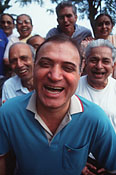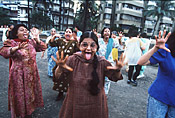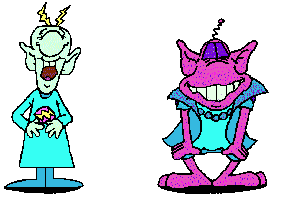

"There are three things in life which are real: God, human folly and laughter. Since the first two are beyond our comprehension, we must do what we can with the third." -- John F. Kennedy
 Dr Madan Kataria of Mumbai, India seems to have decided to do something about it. He is the founder of the Laughter Clubs , now a world wide, widely appreciated movement.
Dr Madan Kataria of Mumbai, India seems to have decided to do something about it. He is the founder of the Laughter Clubs , now a world wide, widely appreciated movement.
|
I often go visit my father , aged 85 in Pune, a couple of hours away from Mumbai. Amongst the early morning , "bustling-back-to-work" sounds that one hears in a typical indian city, I often heard some kind of organised mirthful sounds emanating from the park near my house. On closer inspection , it looked like a unlikely group of people, ranging from retired grandfathers, grandmothers, occasional yuppie types, athletic types, school going types, all having the time of their lives, doing different types of laughs and having lots of fun.
My father who has been a yoga devotee, and confirmed practitioner of alternative medicine since ages, was apparently a member, till his recently diagnosed aortic aneurysm of non-trivial size, sort of forced him to rein in his enthusiasm.
Turns out, that apart from the fun aspect, laughing is excellent therapy for lots of things.
Laughter Clubs, founded by Dr. Madan Kataria, have sprung up around the country in the form of spontaneous, outdoor groups practicing a yogic technique of laughter therapy. People of all ages engage in Lion Laughter, Cocktail Laughter, Silent Laughter and other exercises proven to help control many systems of the body and reduce stress-related diseases.
There is a specific type of laugh, which even benefits the thyroid. Its called the Lion laugh. If you dont believe this, check out : Yogic Simha Mudra: Lion Laughter .
Ho-Ho, Ha-Ha Exercise: If one observes the process of laughter carefully, one will see that during the act of laughter there is a rhythmic movement of the diaphragm (the major respiratory muscle which separates the thoracic cavity from the abdominal cavity), abdominal muscles and intercostal muscles (between the ribs) which helps to expel the air from the lungs in rhythmic jerks which produces rhythmic vibrations from the vocal cords. Also, there is contraction of the throat, palate muscles and facial muscles. There are some dynamic yogic exercises called Kapalbhati, Swash shuddi (cleaning of respiratory passages in forceful jerks of breathing) and Bhastarika, which involve similar rhythmic contraction of all the groups of muscles involved in laughter.
In my search for a method of how to laugh without any reason, when they were told to force themselves to laugh, many people found it difficult to laugh. Therefore, I introduced a warm-up exercise of laughter called Ho-Ho Ha-Ha. People would open their mouth and chant in unison this Ho-Ho Ha-Ha. By doing so, it helped remove inhibitions and there was a sense of participation by the members. The whole atmosphere got charged with laughter and many people would get stimulated and start smiling and giggling.
This Ho-Ho Ha-Ha exercise has some similarity with Kapalbhati, and swash shuddi (Respiratory passage cleaning with jerky movements of abdominal muscles). Later this Ho-Ho Ha-Ha exercise was supplemented with rhythmic clapping of the hands, which gave good stimulation to the acupressure points in the hand. The Ho-Ho Ha-Ha exercise, along with clapping, is done at least 3-5 times at the end of each bout of laughter
Dr Kataria explains :

 |
Reserachers at the Center for Immunilogy at Loma Linda University in California actually studied the neuroimmune parameters during mirthful laughter. This can be found at :
this site
You can also read about "How laughter works ". Click Here to read about GELOTOLOGY, or the physiological study, of LAUGHTER ! |